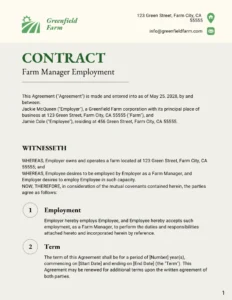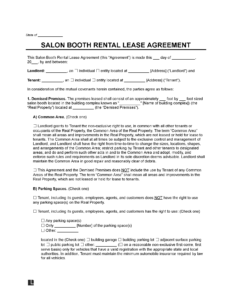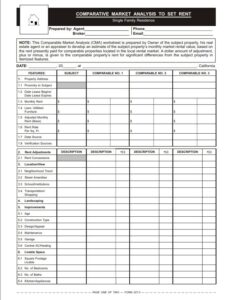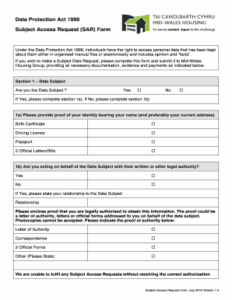Renting out or leasing farm land is a significant decision for both landowners and tenants. It’s a process that, when handled correctly, can lead to productive partnerships and successful agricultural endeavors for years to come. However, without a clear, comprehensive agreement in place, misunderstandings can quickly arise, potentially jeopardizing the farming operation and the relationship between the parties involved.
That’s where a robust farm land rent contract template comes into play. It serves as the backbone of any rental arrangement, laying out the expectations, responsibilities, and terms for everyone involved. Think of it as your roadmap, ensuring that all aspects of the agreement are covered upfront, protecting the interests of both the person providing the land and the one working it. Getting this right from the start can save a lot of headaches down the road.
Key Elements of an Effective Farm Land Rent Agreement
Creating a solid farm land rent agreement might seem daunting, but breaking it down into its core components makes it much more manageable. The goal is to be as specific as possible, leaving no room for ambiguity. A good farm land rent contract template will guide you through all the necessary sections, ensuring you don’t miss any crucial details that could become sticking points later. It’s about building a foundation of clarity and mutual understanding.
First and foremost, any contract needs to clearly identify who is involved. This means the full legal names and addresses of both the landowner (or lessor) and the tenant (or lessee). Equally important is an accurate and detailed description of the farm land being rented. Vague descriptions can lead to disputes over boundaries or specific parcels.
Defining the Parties and Property
When you’re outlining this section, think of it as setting the stage. You need to know exactly who is who and what piece of land is being discussed. This isn’t just a formality; it’s fundamental to the contract’s enforceability. For the property description, more detail is always better.
- Total acreage or specific parcel sizes
- Legal description, often found on property deeds
- Physical address and county where the land is located
- References to maps or aerial photos, if applicable, to mark specific boundaries
Lease Term and Renewal
The duration of the rental agreement is another critical component. Will it be a one-year lease, multi-year, or month-to-month? Clearly state the start and end dates. If there are options for renewal, specify the conditions for renewal, such as notice periods required from either party. This ensures that both sides know when the agreement will expire and what steps need to be taken if they wish to continue the arrangement.
Rent Structure and Payment
This section covers how much rent will be paid and when. There are various ways to structure farm land rent, from fixed cash payments to crop-share agreements where the rent is a percentage of the harvest. Whatever method you choose, detail the exact amount or calculation, the due dates for payments, and the accepted method of payment. It’s also wise to include clauses for late payments, such as interest or penalties, to encourage timely remittances.
Beyond the primary rent, consider other potential financial aspects. Will a security deposit be required? If so, state the amount, the conditions under which it will be held, and how it will be returned. Sometimes, agreements might include provisions for property taxes, insurance, or other operational costs. Make sure these responsibilities are clearly assigned to either the landlord or the tenant.
Navigating Specific Clauses and Considerations
Once the basic framework is established, a comprehensive farm land rent contract template delves into specific clauses that address the practicalities of farming operations and land stewardship. These clauses are designed to protect both the agricultural productivity of the land and the financial interests of the parties involved. Thinking through these details upfront can prevent misunderstandings and ensure a smoother working relationship throughout the lease term.
One vital area is land use and permitted activities. What can the tenant grow or raise on the land? Are there any restrictions on specific crops, livestock, or farming practices? For example, a landowner might specify that no permanent structures are to be built without prior written consent, or that certain soil conservation practices must be followed. Clarifying these points ensures that the land is used in a manner consistent with the landowner’s wishes and sustainable farming practices.
Maintenance and improvements are another key aspect. Who is responsible for maintaining fences, irrigation systems, barns, or other existing structures on the property? If the tenant makes improvements, such as tiling or adding new fencing, what happens to those improvements at the end of the lease? Will the tenant be compensated, or are they considered permanent fixtures of the land? Spell out these responsibilities and expectations clearly to avoid future disputes.
Furthermore, environmental stipulations are becoming increasingly important. Many landowners wish to ensure that their land is managed in an environmentally sound way. This can include clauses regarding nutrient management plans, pesticide use, waste disposal, and adherence to state and federal environmental regulations. By incorporating these into the agreement, both parties commit to responsible land stewardship, which benefits the land long-term.
Finally, consider clauses for dispute resolution and termination. While everyone hopes for a harmonious relationship, it’s prudent to outline a process for resolving conflicts, such as mediation or arbitration, before resorting to costly legal action. Also, specify the conditions under which the lease can be terminated by either party before its natural expiration, including notice periods and any penalties for early termination. This creates a clear path forward, even in difficult circumstances.



